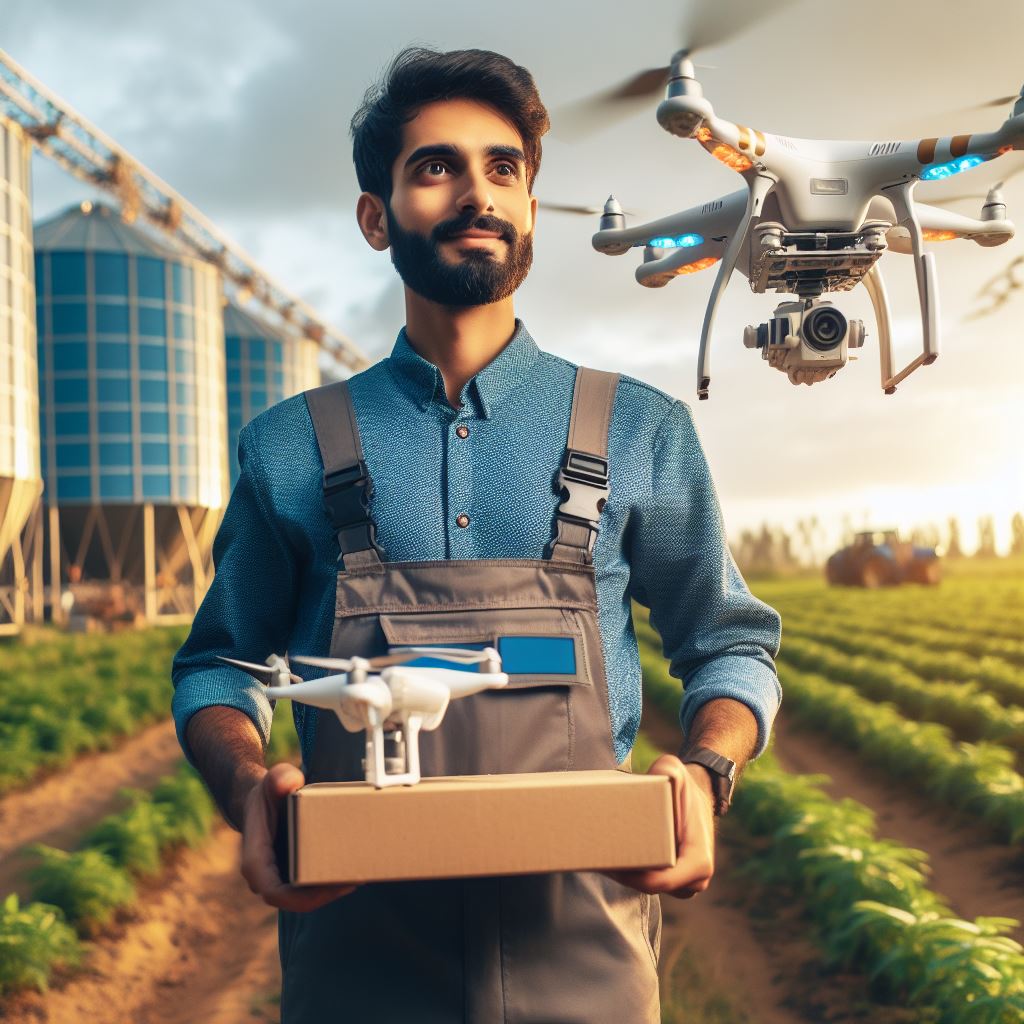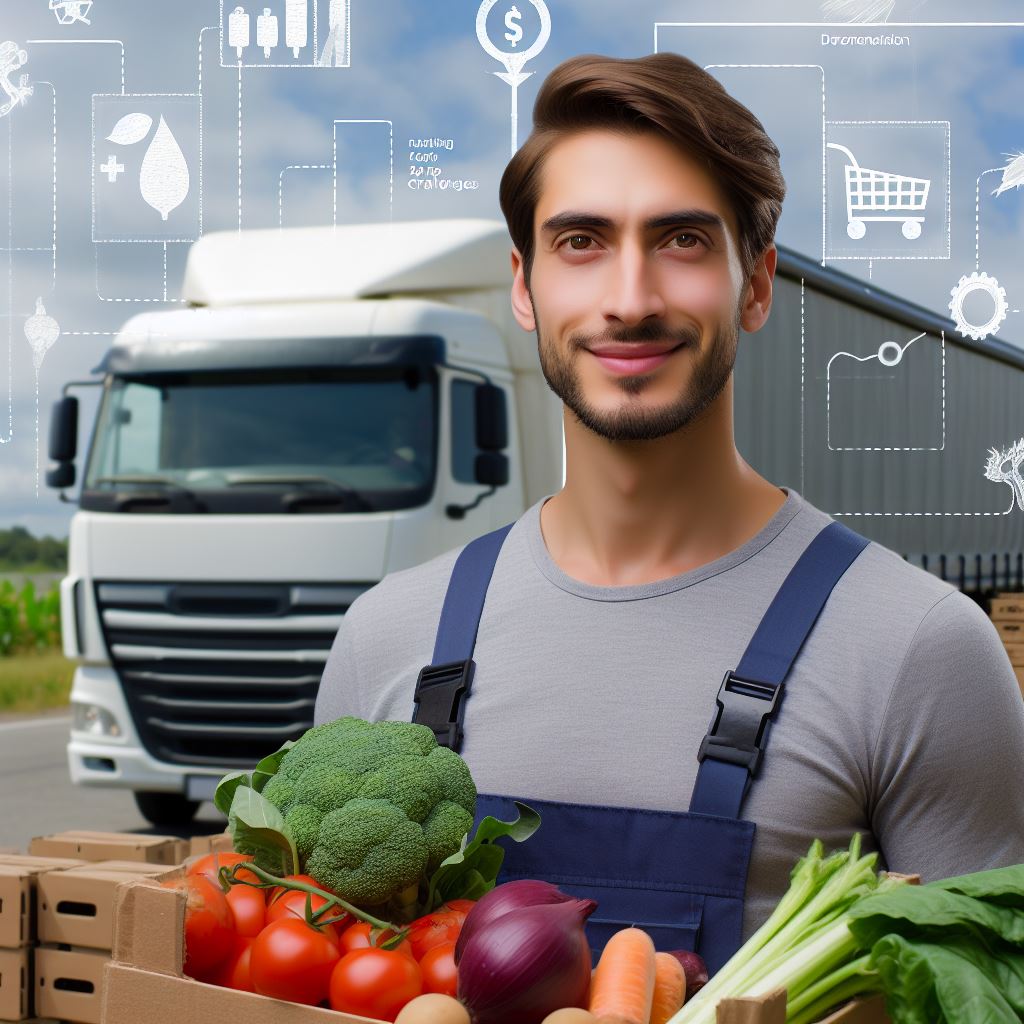Introduction
Let’s explore Drones in Agri Supply Logistics.
Brief overview of drones in agriculture
Drones in agriculture have transformed traditional farming methods, providing innovative solutions for farmers.
These unmanned aerial vehicles (UAVs) offer a range of benefits, including plant health assessments, crop monitoring, and pesticide application.
The ability to capture high-resolution images and collect real-time data significantly improves operational efficiency and reduces costs.
Importance of supply logistics in agriculture
Supply logistics is essential for the agriculture industry, as it involves managing the movement and storage of agricultural inputs and outputs.
Effective supply logistics ensure timely delivery of inputs like seeds, fertilizers, and machinery, as well as efficient transport of harvested crops to markets or processing facilities.
Connecting the two: Optimizing supply logistics with drones
The integration of drones in supply logistics offers numerous advantages.
Drones can be used to transport small packages of agricultural inputs to remote or inaccessible areas quickly.
They can also gather data on inventory levels, enabling farmers to optimize storage and reduce wastage.
Furthermore, drones equipped with GPS and advanced mapping technologies can navigate through fields and identify logistics inefficiencies.
By analyzing patterns and optimizing routes, drones can decrease transportation time and decrease fuel consumption, ultimately reducing costs and carbon emissions.
Overall, the integration of drones in agricultural supply logistics is revolutionizing the industry.
This technology enhances operational efficiency, reduces costs, and minimizes environmental impact.
As drone capabilities continue to evolve, their contribution to optimizing supply logistics is set to increase, benefiting farmers and the entire agriculture ecosystem.
Advantages of Using Drones in Supply Logistics
Drone technology has revolutionized various industries, and the agricultural sector is no exception.
Transform Your Agribusiness
Unlock your farm's potential with expert advice tailored to your needs. Get actionable steps that drive real results.
Get StartedBy incorporating drones into supply logistics, farmers and businesses can take advantage of numerous benefits that enhance efficiency, reduce costs, and improve overall productivity.
Speed and efficiency
1. Quick transportation of supplies
Drones are capable of swiftly transporting supplies from one location to another.
They can navigate through challenging terrains and bypass traffic, ensuring timely delivery of essential goods.
This speed increases overall operational efficiency and minimizes delays in the supply chain.
2. Faster delivery times
With drones, the delivery process becomes more efficient, eliminating the need for traditional methods such as trucks or delivery personnel.
Drones can cover large distances in a shorter time period, enabling businesses to meet customer demands promptly.
This speed results in improved customer satisfaction and increased profitability.
Cost-effectiveness
1. Reduced labor costs
Incorporating drones into supply logistics significantly reduces the need for human involvement.
This reduction in labor requirements leads to cost savings for businesses.
For example, instead of hiring multiple employees for transportation or monitoring tasks, a single operator can manage a fleet of drones, reducing payroll expenses.
2. Savings on fuel expenses
Drones primarily operate on electricity, which is more cost-effective compared to conventional fuel sources.
By using drones instead of traditional vehicles for transportation, businesses can save substantial amounts on fuel costs.
This cost-efficiency positively impacts a company’s financial performance and allows for budget allocation to other areas of agricultural operations.
Enhanced accuracy and precision
1. Accurate inventory tracking
Drones equipped with advanced tracking technology can provide real-time information about inventory levels.
This accuracy allows businesses to monitor stock levels effectively, preventing shortages or excesses.
With accurate inventory tracking, supply management becomes more streamlined, minimizing the risk of stockouts or wastage.
2. Precise crop treatment
Drones can be fitted with sensors and cameras that enable precise crop inspection and treatment.
They can identify areas in need of specific treatments, such as fertilization or pest control, with high accuracy.
This level of precision reduces the use of unnecessary resources and ensures optimal crop health and growth.
In general, the advantages of using drones in supply logistics within the agricultural sector are significant.
The speed and efficiency provided by drones enable quick transportation and faster delivery times, resulting in improved operational efficiency.
Drones also offer cost-effectiveness by reducing labor costs and saving on fuel expenses.
Their enhanced accuracy and precision benefit businesses by providing accurate inventory tracking and precise crop treatment.
Embracing drone technology in supply logistics has the potential to revolutionize the agricultural industry and optimize overall productivity.
Showcase Your Farming Business
Publish your professional farming services profile on our blog for a one-time fee of $200 and reach a dedicated audience of farmers and agribusiness owners.
Publish Your ProfileRead: Agribusiness Laws: An Essential Guide
Applications of drones in agricultural supply logistics
Drones have emerged as a revolutionary technology in various industries, and agriculture is no exception.
When it comes to agricultural supply logistics, drones have found several applications that optimize the process and improve overall efficiency.
Seed and fertilizer delivery
One of the key applications of drones in agricultural supply logistics is seed and fertilizer delivery.
Drones can automate the distribution of seeds and fertilizers, ensuring targeted delivery to specific areas of the field.
With better control over application rates, farmers can minimize wastage and optimize the use of these crucial resources.
Crop monitoring and assessment
Drones play a significant role in crop monitoring and assessment.
Through aerial imaging, drones provide valuable data for crop health analysis.
Farmers can identify problem areas, monitor crop growth, and assess overall yields using real-time data collected by drones.
This allows for timely intervention and helps farmers make informed decisions regarding crop management.
Pest control and crop protection
Drones are also effective in pest control and crop protection.
With targeted spraying capabilities, drones can accurately apply pesticides and fungicides, reducing the amount of chemicals used and minimizing environmental impact.
This precise application method ensures that only the affected areas receive treatment, resulting in more efficient and cost-effective pest control measures.
Drones facilitate early detection of infestations by scanning large areas quickly, enabling farmers to take immediate action and prevent further damage to crops.
The use of drones in agricultural supply logistics offers numerous benefits.
Increased efficiency in seed and fertilizer delivery saves time and labor, allowing farmers to focus on other essential tasks.
The ability to monitor crop health in real-time empowers farmers to make data-driven decisions and implement timely interventions, ultimately improving overall yields.
Targeted spraying of pesticides and early detection of infestations reduce the reliance on harmful chemicals and minimize crop losses.
Their applications in seed and fertilizer delivery, crop monitoring, and pest control have revolutionized the way farmers manage their crops
Embracing this technology enables farmers to improve efficiency, maximize productivity, and promote sustainable practices in agriculture.
As the technology continues to advance, drones will play an increasingly vital role in the future of agriculture.
Read: Farm Policy Updates: Must-Know Info

Challenges and Limitations
Drones have significant potential in optimizing supply logistics in agriculture.
THowever, their use is not without challenges and limitations that need to be overcome for successful implementation.
Regulatory Restrictions
One of the major challenges faced by farmers and agricultural businesses when using drones is the existence of regulatory restrictions.
To ensure safe and responsible drone usage, aviation authorities have put in place strict drone flight regulations.
These regulations control aspects such as altitude limits, flight zones, and the requirement for operators to obtain proper certifications and licenses.
Adhering to these regulations can be time-consuming and may involve additional costs, limiting the full utilization of drones in agricultural logistics.
Privacy concerns also arise when drones are used in collecting data and imagery.
Drones equipped with cameras and sensors can capture detailed information, including crop health data and sensitive farm infrastructure.
This raises concerns about the protection of private information and potential misuse of data.
Addressing these privacy concerns is crucial to gain public acceptance and to ensure compliance with data protection regulations.
Weather Conditions and Terrain
Weather conditions and terrain pose another set of challenges for drones in agricultural logistics.
Wind and rain can significantly affect the stability and performance of drones.
Strong winds may make it difficult for drones to maintain stability and control, while rain can damage sensitive equipment and reduce visibility.
This limits the operational window for drone flights and may require careful monitoring of weather conditions for safe operations.
Complex landscapes, such as dense forests or hilly terrains, can also hinder the efficient use of drones for agricultural logistics.
Navigating through dense foliage or uneven surfaces can be challenging for drones, potentially leading to collisions or the loss of valuable equipment.
Overcoming such challenges may require the development of advanced navigation systems or the deployment of alternative technologies for specific terrains.
Initial Investment and Training
The initial investment required for drone technology can be a limiting factor for farmers considering their adoption.
Showcase Your Farming Business
Publish your professional farming services profile on our blog for a one-time fee of $200 and reach a dedicated audience of farmers and agribusiness owners.
Publish Your ProfileDrones themselves can be expensive, and additional costs may include accessories, software, and maintenance.
Integrating drones into existing supply logistic operations also requires compatible IT systems, which can further increase costs.
Farmers need to carefully evaluate the economic viability and return on investment before committing to the use of drones.
Operating drones effectively also demands specialized skills and training.
Farmers or logistics personnel need to be trained in drone operation, maintenance, and troubleshooting.
This additional skill requirement can lead to either the cost of training or the need to hire external experts.
Ensuring the availability of trained personnel is crucial for the successful integration of drones into agricultural logistics.
Most importantly, while drones offer significant potential for optimizing supply logistics in agriculture, several challenges and limitations must be addressed.
Regulatory restrictions, weather conditions, initial investment, and training requirements are among the key factors that need to be considered for successful implementation.
Overcoming these challenges and leveraging the benefits of drone technology can ultimately revolutionize supply logistics in agriculture, improving efficiency, productivity, and sustainability.
Read: Navigating Agri Subsidies: Expert Tips
Future prospects and advancements
The future of drones in agriculture looks promising, offering several prospects for advancements in supply logistics. Two key areas that hold great potential are the adoption of autonomous drone technology and collaboration between different stakeholders for research and development.
Adoption of autonomous drone technology
With the adoption of autonomous drone technology, AI-powered drones can revolutionize supply logistics in agriculture.
These drones are equipped with advanced artificial intelligence algorithms that enable them to autonomously plan and execute optimized logistics operations.
By leveraging real-time data and utilizing machine learning capabilities, these drones can adapt to changing conditions and requirements, ensuring efficient and accurate delivery of agricultural products.
As a result, farmers can minimize human error, reduce operational costs, and improve overall supply chain efficiency.
In addition to autonomous capabilities, the integration of drones with existing agricultural software systems can further enhance supply logistics in the agriculture sector.
By seamlessly integrating drone operations with other agricultural management processes, farmers can efficiently monitor and manage their supply logistics activities.
This integration enables them to optimize routes, track inventory, and maintain a holistic view of their operations.
Through improved coordination and automation, farmers can streamline their supply chain processes and make informed decisions based on real-time data.
This integration also facilitates effective communication between drones and other agricultural machinery, ensuring seamless collaboration and efficient execution.
Collaboration and research
Collaboration and research play a crucial role in advancing drone technology for agricultural supply logistics.
By bringing together drone manufacturers, software developers, and agricultural experts, joint efforts can lead to the creation of innovative and specialized drone solutions.
These collaborations can result in the development of drones specifically tailored to the unique requirements of the agriculture sector, such as payload capacity, flight range, and environmental adaptability.
Through the exchange of knowledge and expertise, stakeholders can work together to optimize existing drone technologies and develop new capabilities that address the specific challenges and demands of agricultural supply logistics.
Ongoing research and development efforts are necessary to address the limitations of current drone technology in the agriculture industry.
Challenges such as limited battery life, payload capacity, and regulatory restrictions need to be overcome for drones to fulfill their full potential in supply logistics.
Through research initiatives, scientists and engineers can explore new materials, technologies, and operational strategies to improve drone performance and overcome these limitations.
This continuous research and development will drive innovation and pave the way for more advanced and efficient drones in the future.
Essentially, the future prospects of drones in agriculture offer exciting possibilities for optimizing supply logistics.
Adoption of autonomous drone technology and integration with agricultural software systems can greatly enhance efficiency and accuracy in supply chain operations.
Collaboration and research will play a crucial role in advancing drone capabilities and addressing existing limitations.
As the agriculture industry continues to embrace technology, drones are poised to revolutionize supply logistics and contribute to overall sustainable agricultural practices.
Read: Farm Budgets: Maximizing Your ROI
Conclusion
Drones have revolutionized supply logistics in agriculture, offering unprecedented efficiency and accuracy.
Their ability to swiftly transport goods across vast farmlands has streamlined operations and reduced costs.
By optimizing supply chain logistics, drones enable farmers to respond promptly to market demands and fluctuations.
The implementation of drone technology has led to significant time savings and increased productivity on farms.
Drones enhance sustainability by minimizing fuel consumption and carbon emissions associated with traditional transportation methods.
As technology continues to advance, the potential for drones in agriculture is boundless.
Showcase Your Farming Business
Publish your professional farming services profile on our blog for a one-time fee of $200 and reach a dedicated audience of farmers and agribusiness owners.
Publish Your ProfileFarmers who embrace this innovation stand to gain a competitive edge in an ever-evolving industry.
In the coming years, we can expect to see further integration of drones into agricultural supply logistics, unlocking new possibilities for efficiency and growth.
Drones have proven to be indispensable tools for optimizing supply logistics in agriculture, paving the way for a more resilient and sustainable future.




